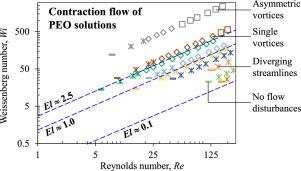Journal of Non-Newtonian Fluid Mechanics ( IF 2.7 ) Pub Date : 2021-02-23 , DOI: 10.1016/j.jnnfm.2021.104508 Sen Wu , Mahmud Kamal Raihan , Le Song , Xingchen Shao , Joshua B. Bostwick , Liandong Yu , Xinxiang Pan , Xiangchun Xuan

|
A comprehensive understanding of the flow of viscoelastic polymer solutions in a contraction and/or an expansion geometry concerns numerous applications. The effects of polymer type, molecular weight, and concentration are investigated through controlled experiments with polyethylene oxide (PEO), polyvinylpyrrolidone (PVP) and hyaluronic acid (HA) solutions in a planar constriction microchannel in a wide range of Reynolds () and Weissenberg () numbers. The polymer structure renders drastic differences amongst the contraction flows of 3000 ppm PEO, PVP, and HA solutions despite having similar molecular weights. The expansion flow vortices of these solutions remain analogous to those in the inertial flow of water. Increasing the molecular weight or concentration of PEO polymer promotes the elastic instabilities in both the contraction and expansion flows. It, however, suppresses (and even blocks) the inertial vortices in the expansion flow and makes them start from the salient corners, in contrast to the lips of the expansion walls in water. Interestingly, a sudden decrease in the size of inertial vortices is observed in the expansion flow of 500 ppm, 1 megadalton PEO solution when the elastic disturbances start appearing in the contraction flow. The observed flow regimes and vortex development in the polymer solutions are summarized in the same dimensionless and parameter spaces, where is the normalized vortex length. The elasticity number, , is found to determine and distinguish the contraction and expansion flows.
中文翻译:

聚合物对平面收缩微通道中粘弹性流体流动的影响
对粘弹性聚合物溶液在收缩和/或膨胀几何形状中的流动的全面理解涉及许多应用。通过在广泛的雷诺兹(Reynolds)平面收缩微通道中使用聚环氧乙烷(PEO),聚乙烯吡咯烷酮(PVP)和透明质酸(HA)溶液进行受控实验,研究了聚合物类型,分子量和浓度的影响()和Weissenberg()号。尽管分子量相似,但该聚合物结构却在3000 ppm PEO,PVP和HA溶液的收缩流之间产生了巨大差异。这些解决方案的膨胀流涡流保持类似于水的惯性流中的那些。PEO聚合物的分子量或浓度的增加促进了收缩和膨胀流动中的弹性不稳定性。然而,与水中的膨胀壁的唇部相反,它抑制了(甚至阻止了)膨胀流中的惯性涡流,并使它们从凸角开始。有趣的是,当弹性扰动开始出现在收缩流中时,在500 ppm 1兆欧PEO溶液的膨胀流中观察到惯性涡旋尺寸的突然减小。 和 参数空间,其中 是归一化涡旋长度。弹性数被发现来确定和区分收缩和膨胀流。











































 京公网安备 11010802027423号
京公网安备 11010802027423号